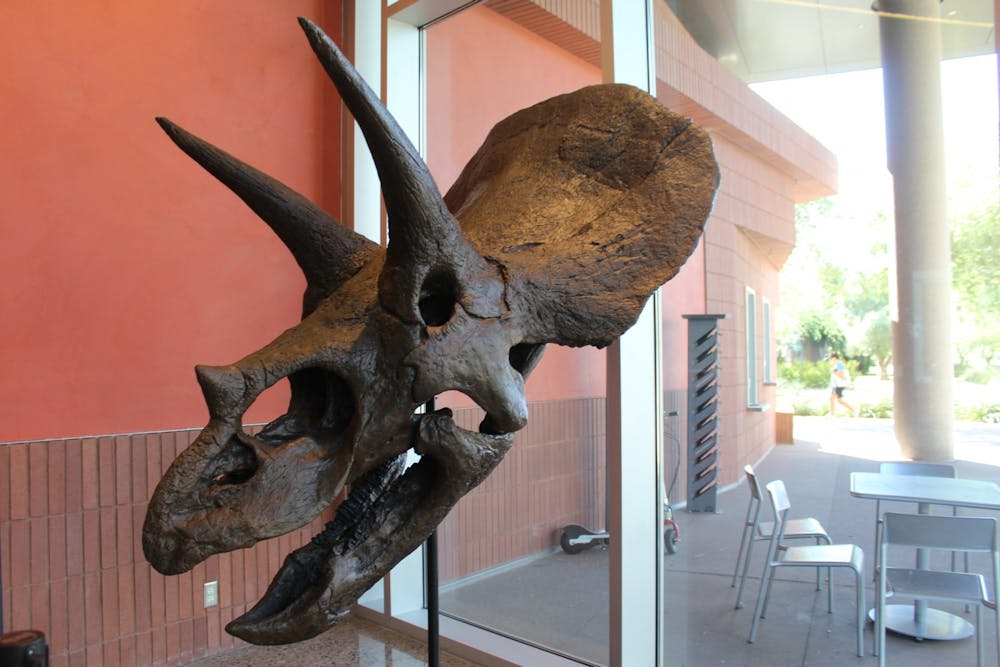The Interdisciplinary Science and Technology Building 4 in Tempe has a plethora of fun things to look at, like a replica of the Curiosity Mars rover and a meteorite collection, but one that sticks out — in three big ways — is Trixie, a replica of a Triceratops skull.
Fossil replicas like Trixie help scientists piece together the story of dinosaurs, and new technology has made it easier to create these replicas that put people face to face with some of the largest creatures to walk the Earth.
Triceratops, a name that translates to three-horned-face, referring to the two horns above its eyes and the smaller third horn on its snout, is a genus of extinct herbivorous dinosaurs that originated in North America and lived among other dinosaurs like the fearsome Tyrannosaurus rex. The dinosaur could reach lengths of 30 feet and could stand nearly eight feet high.
Trixie, which was based on a triceratops skull that was excavated in Montana, was part of a collection that was stored in the George M. Bateman Physical Science Center at the R.S. Dietz Museum of Geology. When the museum closed in 2010, Trixie was moved to where she currently resides in the corner of the first floor in the ISTB 4 building, said Margaret Hufford, coordinator senior in the School of Earth and Space Exploration
“Among the collection of fossils and shells and different things at the Dietz Museum, Trixie, we thought, that she would be good, something old, along with a few fossilized dinosaur eggs (to put in the building),” Hufford said.
Fossils are important for researchers to study because it helps them examine past life. Gary Schwartz, professor at the Institute of Human Origins and the School of Human Evolution and Social Change at ASU, said in an email that fossils are created when bones of dead animals get replaced with inorganic material.
“Fossilization is a complicated chemical process that happens when bones get buried under certain conditions," said Schwartz in an email. "Over time, the organic components of bones, teeth, etc., (are) slowly replaced with inorganic material from the surrounding sediments. Once all of the organic material is replaced with inorganic minerals, the once bone/tooth is now a fossil. So, essentially, fossils are as hard and as inorganic as rocks."
However, actual fossils are delicate, and they can deteriorate if they are not in a controlled environment, according to The Paleontology Portal. Because of this, fossil casts are important because they can help preserve real fossils, said Douglas Wolfe, a freelance paleontologist and co-founder of Zuni Dinosaur Institute For Geosciences who discovered a dinosaur the Zuniceratops.
Also, fossil replicas are much lighter than actual fossils, making them easier for researchers to transport and share with other members of the scientific community, Wolfe said.
“It’s a lot easier to hand a cast around or send a cast to a colleague to say, 'Hey what do you think of this thing?’ than it is to send a real bone,” Wolfe said. “So the casts are very important in the early research.”
The process of creating a fossil replica varies on the person or the museum, Wolfe said.
One popular method of making a fossil replica is called the "mold and cast" method: A mold is created by painting the fossil with liquid rubber and covering it in fiberglass, then the mold is filled with a resin or plastic to create the cast — which can be painted to more accurately resemble the real fossil — according to HowStuffWorks.
The process of making a fossil cast has changed drastically over time due to new 3D scanning technology, Schwartz said in an email.
"These days, however, casts are often made by 3D scanning the original specimen and then using a 3D printer to generate a cast,” said Schwartz in an email.
Fossil casts help scientists tell the story of the past in an exciting and tangible way, and Hufford said having a fossil cast in ASU's collection is awesome.
"Trixie is storied and we just think she is very cool," Hufford said.
Edited by Kaden Ryback, Wyatt Myskow and Kristen Apolline Castillo.
Reach the reporter at mtvega1@asu.edu and follow @madivega18 on Twitter.
Like The State Press on Facebook and follow @statepress on Twitter.
Continue supporting student journalism and
donate to The State Press today.




